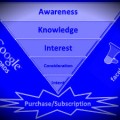Influencer marketing is a practice where you focus your marketing efforts on key individuals that can influence your buyers into purchasing your products or services. Influencer marketing can be used both in B2B and B2C environments. Influencer marketing can focus on marketing to, through and/or with influencers. Influencer marketing does not replace traditional marketing, it complements it.
Origins of influencer marketing
Influencer marketing has its roots in relationship and peer to peer marketing theory. It is also strongly influenced by psychological theories such as choice making and confirmation bias. The mechanics of it are partly explained in Malcolm Gladwells’s Tipping Point.
Influencer marketing is not new. Actually, is it possibly, in the form of word of mouth marketing, the oldest marketing tactic there is. Advertising while using a celebrity to promote products or services is also a form of influencer marketing.
Both of these tactics have serious shortcomings. Word of mouth, despite being one of the most powerful types of influencer marketing lacks in scalability. As for advertising with celebrities, it lacks the two-way communication potential which increases the effectiveness of this type of marketing.
Enters the social media platforms, they enable direct, two-way communication on a very large scale. Thus making influencer marketing a potentially powerful tool to increase your conversion rates and sell your products or services to large numbers of customers.
What makes an influencer?
According to Kyle Wong, CEO of Pixlee and influencer marketing authority, you can measure influence with this equation:
Influence = Audience Reach (# of followers) x Brand Affinity (expertise and credibility) x Strength of Relationship with Followers
The formula itself is sound but the variables should not be separated from their ‘’ecosystem’’ to be of any use.
The number of followers of an influencer is important but not as much as the quality of their followers in regards to your product or service. Only the followers that will relate to your brand should be counted. An example would be if you are trying to sell luxury sporting goods and your influencer is an extreme sport athlete. Said athlete is not only known for her sport but also for her dabbles in indie music and implication in inner-city shelters for battered women. She may very well have over 200 000 followers, excellent expertise, credibility and have a very strong relationship with her followers but she may not prove to be much of an influencer on your potential customers. First, only a fraction of the followers are in it for the extreme sport aspect and may have value to the luxury sporting goods company. Second, her relationship may be stronger with the people who follow her for her activities other than extreme sport. Not to mention that her entire image is less about luxury than about non consumerism and social conscience. Hence her influence regarding your brand may be lost on the majority of her followers.
In general, influencers are popular, activists, looked up to, who embody the prevalent values of your targeted customer segments, are knowledgeable about products/services similar to yours and are inspiring.

Inner workings of influencer marketing
Influencer marketing works best when:
A) Your buyers feel they don’t have all the necessary information in order to make a purchase decision, and
B) Stakes are high
In the first case it can either be that the product/service is so complex or has so many facets to know about that the purchaser can’t or doesn’t feel like going through all the information before making a decision. This is often the case in the B2B environment. Purchasers cannot get hold of sufficient information to make a decision and will rely on a (or many) trusted third party to make their decision. In the B2C environment, it can be when there are so many competing products that the buyer doesn’t have the time or inclination to compare them all.
Influencer marketing is also very effective when the product or service purchase is highly significant to the purchaser. This is often the case in B2B environment or when the purchase price represents a high percentage of the buyer’s income. In such cases, part of the burden of making an important decision will be differed to the referencer.
In a future post we will look at influencer marketing tactics, its dos and don’ts and potential limitations.









